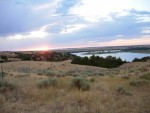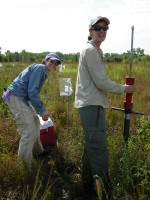Humans have long relied on nutrient fertilizers to improve crop yields and garden bounties. Increasing fertilizer production, along with increasing cultivation of nitrogen-fixing crops (like soybeans) and combustion of fossil fuels, have all contributed to a steady rise in nutrients worldwide. These changes in global nutrient availability influence the global carbon cycle as well: increasing nutrients can also increase plant growth, or the capture of carbon dioxide (CO2) and its transformation to organic carbon during photosynthesis.
Nutrient enrichment can also change the decay rate of soil carbon by soil micro-organisms, a process that releases CO2 to the atmosphere. Soils are a large reservoir of fixed organic carbon. Consequently, understanding the extent to which soil decay contributes to atmospheric CO2 is especially important for predicting future global climate. Unfortunately, the effects of increased nutrient inputs on soil carbon are still poorly understood. How do increased nutrients influence soil carbon decay? What are the effects on soil chemistry and microbial activity?
My graduate research is addressing these questions using ongoing nutrient addition experiments that are participatory sites of the Nutrient Network, or NutNet, an international grassland research network. NutNet includes participatory sites across the globe and many of its U.S. experiments are located at Long Term Ecological Research (LTER) Network sites. While my research has focused on processes occurring belowground, NutNet uses a network science approach to address important research questions. The NutNet team is learning how changes in nutrients and grazers impact the whole ecosystem – from plants to insects to pathogenic fungi and beyond – and how these effects vary across and between continents.
As a graduate student, participation in NutNet has provided opportunities to sample soils from several sites in the U.S. Central Great Plains, including three current and former LTER sites. I am also using the larger NutNet datasets to understand how my regional study relates to soil carbon responses NutNet is observing at the global scale. And throughout all of this work, I have enjoyed participating in the human network of NutNet/LTER. NutNet annual meetings have been an opportunity to meet scientists with diverse expertise, soak up some of the group’s statistical expertise, and get critical feedback on my research. Above all, the ability to leverage existing ecological experimental infrastructure and build connections across research networks has been invaluable.

 Enlarge this image
Enlarge this image
